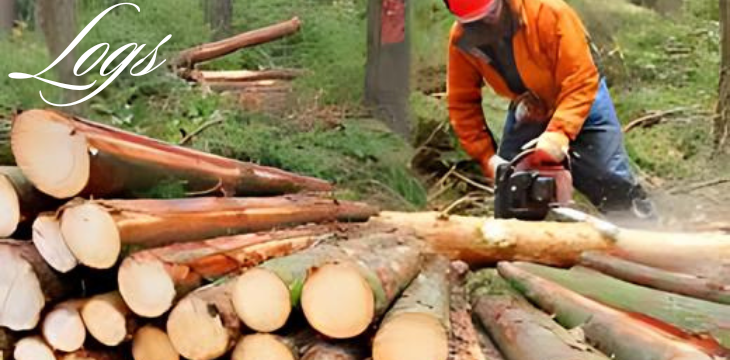Logs—those simple, sturdy chunks of wood that often get taken for granted. We see them lying around in forests, stacked up in firewood piles, or turned into furniture and paper. But have you ever stopped to wonder about their fascinating journey? From their origins in ancient forests to their crucial role in modern industry, logs have a story that’s far more interesting than you might think. Buckle up as we delve into the surprisingly complex world of logs and discover their many lives beyond the lumberyard!
The Origins of Logs: A Tree’s Tale
From Saplings to Stalwarts
Logs start their lives as tiny saplings, reaching for the sky and soaking up sunlight. Over time, they grow into towering trees, their trunks gaining strength and resilience. Here’s a quick rundown of their growth:
- Seedling Stage: The humble beginnings, where a tiny seed pushes its way through the soil.
- Young Tree: Branches start to spread, leaves unfurl, and the tree begins to grow in height and girth.
- Mature Tree: Fully grown, the tree’s trunk is now a solid log, ready for its next chapter.
Forest Giants: The Unsung Heroes of Ecosystems
In the forest, logs play a crucial role in maintaining ecological balance. They provide habitats for countless species, from fungi to insects, and even mammals. Think of them as nature’s very own recycling system, breaking down and returning nutrients to the soil. Without log, forests would be missing a key ingredient in their complex ecosystem recipe.
The Transformation of Logs: From Trees to Treasures
Logging: A Craft and a Science
When it’s time to turn those forest giants into usable wood, the logging process kicks off. Here’s how it typically goes:
- Harvesting: Trees are, felled using specialized equipment. This is, often done with precision to ensure minimal impact on the surrounding environment.
- Processing: Logs are cut into various sizes and shapes, depending on their intended use. Sawmills play a major role in this transformation.
- Treatment: To prevent decay and pests, log are, often treated with chemicals or heat.
From Logs to Lumber: Crafting the Basics
Once processed, logs become lumber, a versatile material used in countless applications. Here’s a peek at what lumber can become:
- Furniture: Tables, chairs, and beds—all made from meticulously cut and treated wood.
- Building Materials: From framing houses to flooring, lumber is a cornerstone of construction.
- Paper Products: Yep, logs are the raw material for paper, cardboard, and other paper-based products.
Logs in Culture: More Than Just Wood
A Toast to Logs: The Role in Traditions
Logs have a way of popping up in cultural traditions around the world. Here’s a fun look at how different cultures use log:
- Log Fires: There’s nothing like a cozy log fire to warm up a chilly evening. Logs crackle and pop, creating a comforting atmosphere that’s hard to beat.
- Log Cabins: These rustic homes, often found in the American frontier, are built from log, reflecting a deep connection to the land and its resources.
- Yule Logs: In some cultures, a special log is, burned during winter holidays to bring good luck and celebrate the season.
Logs in Art: Crafting with Nature
Artists and craftspeople have long been, inspired by logs. Whether sculpting intricate designs or crafting beautiful wooden bowls, log offer a canvas that’s both natural and full of potential. Their unique textures and grains make each piece one-of-a-kind.
The Future of Logs: Sustainability and Innovation
Green Logging: The Move Towards Sustainability
With increasing awareness about environmental issues, the logging industry is shifting towards more sustainable practices. Here’s what’s happening:
- Selective Logging: Instead of clear-cutting, selective logging focuses on removing only certain trees, allowing the forest to regenerate more easily.
- Reforestation: Planting new trees to replace those that are harvested helps maintain the ecological balance.
- Certified Timber: Look for timber products that have certification from organizations like the Forest Stewardship Council (FSC), ensuring they come from responsibly managed forests.
Innovations in Log Use: Beyond the Usual
Technology is pushing the boundaries of how logs can be, used. Some exciting innovations include:
- Biomass Energy: Log are being used to create renewable energy sources, reducing our reliance on fossil fuels.
- Log-Based Products: From innovative furniture designs to advanced building materials, the potential of logs is continually expanding.
FAQs
Q: How long does it take for a log to decompose naturally? A: The decomposition time for a log can vary widely depending on factors like climate, wood type, and environmental conditions. On average, it can take several years to several decades.
Q: Can I use logs from my own property for firewood? A: Yes, you can use logs from your property for firewood, but make sure they’re properly seasoned to avoid excessive smoke and creosote buildup.
Q: What’s the best way to store logs for firewood? A: Store logs in a dry, well-ventilated area, off the ground to prevent moisture absorption. A covered woodpile or rack works great!
Conclusion
Logs might seem like simple, ordinary things, but they’re anything but. From their crucial role in forest ecosystems to their many uses in human industry and culture, log are a testament to nature’s ingenuity. Whether you’re cozying up by a log fire, admiring a piece of wooden art, or thinking about the future of sustainable logging, remember that these humble wooden wonders have a story that’s rich and varied. So next time you see a log, take a moment to appreciate the journey it’s been on and the many ways it continues to shape our world.
